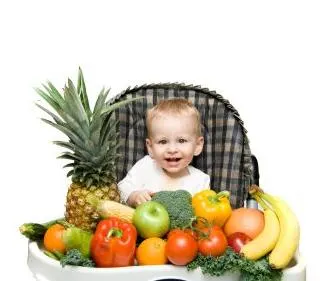Aside from the flavour, the reason many of us opt to buy organic produce is to avoid the pesticide residues that may be present in foods farmed using conventional methods. This is a precaution that becomes even MORE important when cooking for our babies.
 But organic food can be expensive or difficult to get hold of, so being able to identify exactly WHICH fruits and vegetables are the most harmful in terms of pesticide residues is extremely useful.
But organic food can be expensive or difficult to get hold of, so being able to identify exactly WHICH fruits and vegetables are the most harmful in terms of pesticide residues is extremely useful.
Well, thanks to the Environmental Working Group’s ‘Dirty Dozen’ list, identifying those fruits and vegetables is easy.
The Dirty Dozen report is compiled from data collected by the U.S. Department of Agriculture and the Food and Drug Administration. It is based on the amount of pesticide residues the tested samples contain as they would typically have been eaten, after washing or peeling.
The Environmental Working Group also produces a second list, called the ‘Clean 15’, made up of all those fruits and vegetables that are found to contain the least amount of pesticide residues. The need to buy the organic version of these foods is far less important, making it easier for you to prioritize at the grocery store!
The 2012 lists have just been released and there are a couple of changes to note.
Cucumbers have now been added to the Dirty Dozen list, and a new list – called the ‘Plus Category’ – has been created. This new category lists all those foods that don’t quite meet the criteria for inclusion as one of the Dirty Dozen, but that are still frequently contaminated with toxic organophosphate insecticides. Collard greens/kale and green beans have been moved from the main list to this ‘Plus Category’.
For the first time, this year’s report includes commercially prepared baby food. Around 190 samples of green beans, pears and sweet potatoes prepared and marketed as baby food and dated from 2010, were tested.
Whilst sweet potatoes sold as baby food contained almost no detectable residues, both green beans and pears DID. 9.4% of samples contained the organophosphate methamidiphos and 7.8% contained the organophosphate acephate. The Environmental Working Group’s report states:
Based on our calculations, a 22-pound child eating one four-ounce serving of green beans sold as baby food with the maximum methamidiphos level found would consume 50 percent of EPA’s acute risk value, a measure of allowable risk. The risks would be higher if the beans were contaminated with a second organophosphate, acephate, which causes the same damages to the brain and nervous system. Lighter babies, those fed more than four ounces of green beans or those fed green beans with organophosphate residues daily would be at still greater risk.
The news about pears was even worse… a staggering 92% of the pear samples contained at least one pesticide residue and around 26% contained five or more, including the pesticide iprodione, categorized by the EPA is a probable human carcinogen. Iprodione is not registered with the EPA for use on pears and the fact that it is being found in (according to the EWG report) a ‘popular baby food’ is a violation of FDA regulations and the Federal Food, Drug and Cosmetic Act.
It is also extremely alarming for parents and an even greater incentive to prepare baby food at home, where you can take measures to ensure that fruits and vegetables you feed your baby are as safe for him to eat as possible.
For a full list of all the fruits and vegetables included in the Dirty Dozen – plus the ‘clean list’ of produce that you can buy with greater confidence – please see this page:
Should I Peel Fruit and Vegetables from My Baby?
Source for this article: www.ewg.org
